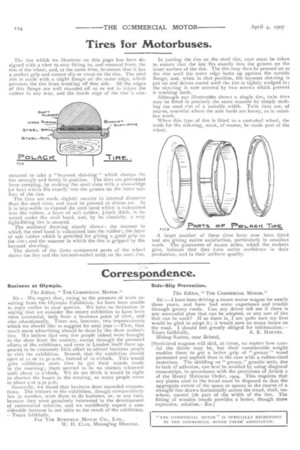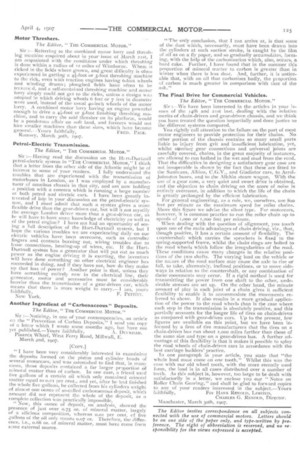Correspondence.
Page 18

Page 19

If you've noticed an error in this article please click here to report it so we can fix it.
Business at Olympia.
The Editor," THE COMMERCIAL MOTOR."
Sir :--We regret that, owing to the pressure of work resulting from the Olympia Exhibition, we have been unable to reply earlier to your queries. We have no hesitation in saying that we consider the recent exhibition to have been most successful, both from a business point of view, and • also educationally. There are however, two improvements which we should like to suggest for next year :—First, that much more advertising should be done by the show authorities. We believe that very few people indeed were brought to the show from the country, except through the personal efforts of the exhibitors, and even in London itself there appeared to be extremely little effort to attract business people to visit the exhibition. Second-, that the exhibition should open at mm or 11.30 a.m., instead of ma o'clock. This would give exhibitors more time to get their stands ready in the morning; there seemed to be no visitors whatever until about 12 o'clock. We do not think it would be right to shorten the hours in the evening, as many people came in about 9 or 9.30 p.m.
Gem-rally, we found that business done exceeded expecta tions. The visitors to the exhibition, though comparatively few in number, were there to do business, or, at any rate, because they were genuinely interested in the development of commercial vehicles, and we confidently expect a considerable increase in our sales as the result of the exhibition. —Yours faithfully,
For THE RYKNIELD MOTOR CO., LTD., W. H. CLAY, Managing Director. Side-Slip Prevention.
The Editor," THE COMMERCIAL MOTOR."
Sir :—I have been driving a steam motor wagon for nearly three years, and have had some experience and trouble through greasy roads. Can any driver tell me it there is any successful plan that can be adopted, or any sort of tire that can be used? If so there is, I am quite sure my firm would be glad to adopt it; it would save us many hours on the road. I should feel greatly obliged for information.— Yours faithfully, A. E. HARVEY. Bishop Sutton, near Bristol,
[Steel-tired wagons will skid, at times, no matter how careful the driver may be, but their considerable weight enables them to get a better grip of " greasy " wood pavement and asphalt than is the case with a rubber-tired motorbus. The skidding on "greasy," granite setts, due to lack of adhesion, can best be avoided by using diagonal cross-strips, in accordance with the provisions of Article 2 of the Heavy Motorcar Order, 1904. This requires that any plates used in the tread must be disposed so that the aggregate extent of the space or spaces in the course of a straight line drawn horizontally across the tread, shall, nowhere, exceed *th part of the width of the tire. The fitting of wooden treads provides a better, though more expensive, solution.—En.]
Motor Threshers.
The Editor, " THE COMMERCIAL MOTOR."
Sir :—Referring to the combined motor lorry and threshing machine enquired about in your issue of March 21st, I am acquainted with the conditions under which threshing is done within a radius of 12 miles of Wimborne. Wheat is ricked in the fields where grown, and great difficulty is often expereenced in getting a 41-foot or 5-foot threshing machine to the rick, even 'with traction engines having 6-foot wheels and winding drums; ploughed fields have often to be trevers:d, and a self-contained threshing machine and motor lorry simply could not get to the ricks, unless a design was adopted in which driving wheels 6 feet or 7 feet in diameter were used, instead of the usual 4o-inch wheels of the motor lorry. A combined motor lorry haying an engine powerful enough to drive a 4:7-foot or 5-foot finishing threshingmachine, and to carry the said thresher on its platform, would be a ponderous affair on soft land, and farmers would not hire smaller machines than these sizes, which have become
general--Yours faithfully, FRED. PAGE. RuMSey, March 3oth, 1907.
Petrol-Electric Transmission.
The Editor, "THE COMMERCIAL MOTOR."
Sir :—LIaving read the discussion on the 1-krt-Doetoail petrol-electric system in "TnE COMMERCIAL MOTOR," I think that a letter from the other side of the Atlantic might be of interest to some of your readers. I fully understand the troubles that are experienced with the transmission of motorbuses in London, as I was employed by a manufacturer of omnibus chassis in that city, and am now holding a position with a concern which is running a large number or both petrol and electric cars. I have been greatly inter ested of late in your discussion on the petrol-electric system, and I must admit that such a system gives a more flexible drive than the gear-driven car, but will it not mystify the average London driver more than a gear-driven car, as he will have to have sonic knowledge of electricity as well as of the petrol engine? I have not had an opportunity of seeing a full description of the Hart-Durtnall system, but I hope the various troubles we are experiencing daily on our electric vehicles have been overcome, such as controller fingers and contacts burning out, wiring troubles due to loose connections, heating-up of wires, etc. If the -HartDurtnall system has a generator that will put out as much power as the engine driving it is exerting, the inventors will have done something no other electrical engineer has succeeded in doing, and if they have not, how do they make up that loss of power? Another point is that unless they have something entirely new in the electrical line, their generator, motor and accessories must be considerably heavier than the transmission of a gear-driven car, which means that there is more weight to carry.—I am, yours
faithfully, F. PETTITT. New York.
Another Ingredient of "Carbonaceous" Deposits.
The Editor," THE COMMERCIAL MOTOR."
Sir :—Noticing, in one of your contemporaries, an artic2e oa the " Prevention of Carbon Deposits,'' I send you copy of a letter which I wrote some months ago, but have not yet publish-ed.—Yours faithfully, A. DUCKNAM. Phenix Wharf, West Ferry Road, Millwall, E. March 2nd, 1907.
[Com]
" I have been very considerably interested in examining the deposits formed on the piston and cylinder heads of several motorcars, and was astonished to find that, in many cases, these deposits contained a far larger proportioo of mineral matter than of carbon. In one case, a friend used five gallons of a certain oil which only contained mineral matter equal to o.ot per cent., and vet, after he had finished the whole five gallons, he collected from his cylinders weight of almost one ounce of so-called carbonaceous deposit, which amount did not represent the whole of the deposit, as a complete collection was practically impossible.
" Now, this ounce of deposit, on analysis, showed the presence of just over 0.75 oz. of mineral matter, largely of a silicious composition, whereas o.ot per cent, of five gallons of the oil only means 0.07 oz. Therefore, the difference, i.e., 0.68 oz. of mineral matter, must have come from same external source. •
"-The only conclusion, that I can arrive at, is that some of the dust which, necessarily, must have been drawn into the cylinders at each suction stroke, is caught by the film of oil as on a fly paper, and so gradually accumulates, forming, with the help of the carbonisation which, also, occurs, a hard cake. Further, I have found that in the summer this proportion of mineral matter to carbon is greater than in winter when there is less dust. And, further, it is noticeable that, with an oil that carbonises badly, the proportion of carbon is much greater in comparison with that of the ash."
The Final Drive for Commercial Vehicles.
The Editor, "THE COMMERCIAL MOTOR."
Sir :—We have been interested in the articles in your issues of the 14th and 21st inst. dealing with the relative merits of chain-driven and gear-driven chassis, and we think you have treated the question impartially and done justice to the different systems compared. You rightly call attention to the failure on the part of most motor engineers to provide protection for their chains. No other portion of the chassis contains so many small parts liable to injury from grit and insufficient lubrication, yet, whilst steering, gear connections and universal joints are carefully covered, chains, in the great majority of instances, are allowed -to run bathed in the wet and mud from the roed. That the difficulties in designing a satisfactory gear case are not insuperable is shown by the fact that these are fitted to the Sunbeam, Albion, C.G.V., and Gladiator cars, to Arr61Johnston buses, and to the Allchin steam wagon. With the use of a gear case, a very quiet and sweet drive is obtained, and the objection to chain driving on the score of noise is entirely overcome, in addition to which the life of the chain is greatly prolonged by the efficient lubrication. For general engineering, as a rule, we, ourselves, use Soo feet per minute as the maximum speed for roller chains. Above this figure we advise the silent type. For motorcars, however, it is common practice to run the roller chain up to speeds of t,000 or 1,200 feet per minute. When dealing with the question of alignment, you touch
upon one of the main advantages of chain driving, viz., that, though positive, it has a certain amount of flexibility. The countershaft which carries the sprockets is fixed to the spring-supported frame, whilst the chain rings are bolted to the road wheels which follow the irregularities of the road. These conditions cause many changes in the relative positions of the two shafts. The varying load on the vehicle or the naure of the road surface may cause the axle to rise or fall, to take, alternately, inclined positions, or to move sidewars in relation to the countershaft, or any combination of these movements may occur. If a rigid method is used for transmitting the power from one shaft to the other, undesirable stresses are set up. On the other hand, the minute amount of play in each joint of a chain gives it sufficient flexibility to enable it to accommodate the movements referred to above. It also results in a more gradual application of the power to the road wheels than is the case where each step in the transmission is absolutely positive, and this partially accounts for the longer life of tires on chain-driven as compared with gear-driven cars. Up to the present, few figures are available on this point, but we have been informed by a firm of tire manufacturers that the tires on a chain-driven bus run about 2,000 miles further than those of the same size and type on a gear-driven bus. A further advantage of this flexibility is that it makes it possible to splay the road wheels of chain-driven cars in accordance with the best carriage builders' practice.
In one paragraph in your article, you state that "the whole load must come on one tooth." Whilst this was the case with our old wheel tooth, with the more recently used form, the load is in all -cases distributed over a number of teeth. As this subject is, however, too large to be dealt with satisfactorily in a letter, we en-close you our " Notes on Roller Chain Gearing," and shall be glad to forward copies to any of your readers interested in the subject.—Yours faithfully, For HANS RENOT.13, LIMITED, CHARLES G. RENOLD, Director. Manchester, March 3oth, 1907.


























